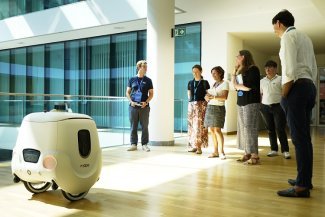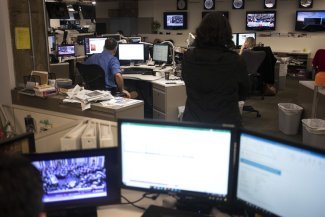
An image of a robot waiter, alongside a human waiter, at the Da Bruno Sul Mare restaurant in Marbella, Spain.
It is 56 centimetres high and weighs 55 kilos. Its body – plastic and aluminium alloy – is able to move and avoid obstacles with agility. Its face – an LED screen – greets, smiles and even sings if asked to. It is Bellabot, the first robotic waiter, imported from China and already being used in many European restaurants.
The robot is programmed to serve and clear tables. It can carry up to four trays – 40 kilos at a time – in a single trip, and work 24 hours without tiring. It is faster and more efficient than its co-workers, human co-workers, that is. Is this the end of real live waiters? Fear not. The answer is no, most probably not.
Bellabot is a cobot, a collaborative robot designed to assist workers with the most mechanical, tedious, repetitive or heavy aspects of their day-to-day work. It is used in warehouses, to transport goods, in factories, for routine work, in restaurants, to serve and take away dishes. The cobot saves time, avoids injuries and works alongside humans. It does not replace them.
The future of work, according to the World Economic Forum, will look something like this – or more like this, at least, than the alarming prospect of mass job losses caused by robots. Few jobs, they say, are fully automatable. What will be automated for sure are certain tasks, the most physical, the most repetitive. Around 60 per cent of jobs are estimated to have at least 30 per cent automatable tasks. Artificial intelligence such as ChatGPT, for example, is expected to be able to take on at least 10 per cent of certain language-related tasks.
“If it’s well managed, it could bring very positive changes. What springs to mind are all the workplace accidents that can be avoided, all that physical or mental workload that we can do away with,” anthropologist Bárbara Urban tells Equal Times.
“Ideally, the robots will take care of the heavy, dangerous, tedious work and the people with them will have more time for training, a better work-life balance, they will work less, work better.” In the case of waiters, thanks to Bellabot, they will be able to spend less time going back and forth and more time with the customers.
Seen from this perspective, we are moving towards a new division of labour in which humans that can compete with machines will not be sought after but humans that are able to contribute what machines cannot.
Lifelong learning
A tip for the workers of the future? José Varela, head of new technologies at Spain’s UGT trade union, sums it up in two words: “Digital skills.” From the most basic, “such as managing video calls”, to more complex ones, such as how to work with certain programmes. “I would even start thinking about doing a little programming course.”
Working hand in hand with machines will inevitably require a knowledge of their language. This does not mean everyone will need an in-depth knowledge – that will only be required of those who develop the technology – but simply knowing how to use Excel will not be enough either. With the advent of artificial intelligence, simple administrative tasks – especially data collection and processing – are as much at risk as the heavier tasks. They will be done by algorithms and many more people than anticipated are likely to be affected.
“The core of industrialised societies, the middle classes, have been essentially built on these types of middle-skilled jobs,” warns Arturo Lahera, an occupational sociology professor at the Complutense University of Madrid (UCM). “They will have no choice but to retrain.”
Two concepts are often repeated in the business world: upskilling and reskilling. The first is about upgrading, learning new skills and tasks within the same job. The second refers to retraining, that is, training to enter a different field of work. In both cases, it seems clear that learning is going to be the backbone of the work of the future. Gone are the days of a training phase followed by an employment phase. From now on, lifelong learning is set to be a right and an obligation.
“We need a lifelong approach to learning. We can’t think that when school is over, that’s it. The chances are that our jobs will change throughout our lives. Not only because of technological change, change is everywhere. We have seen it with Covid,” says Jordi Serrano, founder of the Future for Work Institute in Barcelona.
Serrano speaks of the end of hyper-specialised workers, of the need for hybrid profiles, with a knowledge of science and humanities, T-shaped profiles. “The horizontal stick would be cross-cutting knowledge of several areas, the vertical stick would be in-depth knowledge of one specific field. We need a combination of the two.”
If there is a generation that is used to hybridity, it is Generation Z, the generation that is graduating from university now. Elsa Arnaiz, president of the Madrid-based youth organisation Talent for the Future, who has a degree in Law and International Relations and a master’s degree in big data, is one such example. “Right now, I know a lot of people with arts and humanities backgrounds that are taking programming courses, and people with science backgrounds taking creative writing courses,” she says.
“In any case, I think that if there is one area where we are going to need lifelong learning in the future, it will be in what are known as soft skills, such as creativity, leadership, critical thinking, knowing how to navigate uncertainty. Those are the skills we really need to acquire. More than just keeping up to date with the latest software (which is also necessary), we need to harness all those skills that machines don’t have. It is true that the younger generations have the advantage of knowing how to live with uncertainty but, to be honest, we are not as worried about the automation of the future as we are about the unemployment of the present.”
The losers
The concept of “lifelong learning” still raises a number of questions. If it is considered a right, will it be part of public education? Will it be freely available to all? And will it take place during or outside working hours? One thing is clear, it cannot depend on employees alone. Companies and public authorities will have to work together to lead this change.
“We have a problem,” says José Varela of the UGT, “And that is that people are not being prepared for this change. Companies do not have a specific strategy. Nor are governments deploying measures.” As Serrano also explains: “A sense of urgency is lacking.”
While we talk about robots and algorithms, nearly three billion people around the world are still trapped in the digital divide.
For all these reasons, some people are already talking about the “losers” in this labour transition. “We have to bear in mind that there are life paths that cannot be changed from one day to the next. Some workers, especially the least qualified, will have trouble retraining,” says sociologist Lahera. “We need to consider how to redirect these people to other, less digitised, more socially relevant jobs, such as care work. But this is where we run into the usual difficulty. Such jobs are still undervalued and very poorly paid.”
Academic studies and organisations such as the European Union and the International Labour Organization warn of a foreseeable increase in labour inequality, a process of polarisation between highly qualified and well-paid workers and those, especially those currently in intermediate occupations, who are pushed into new precarious employment such as clickwork, micro-tasks or the training of algorithms.
“The automation of work is going to affect the quality of employment more than the quantity,” warns Varela. The problem is not that machines are going to take our jobs but that they will move us towards worse jobs. The way to avoid this, adds the union spokesperson, “is to take a preventive training approach,” but also to appeal to the responsibility of companies, those set to benefit from all this technology. Anthropologist Bárbara Urban points to the example of South Korea, where companies with robots “are already paying an indirect tax for social purposes”.
The problem we are facing is not technological,” says Lahera. “It is a labour relations issue, just as it was in the 1980s with the outsourcing and relocation phenomenon. Before all this happens, we need to negotiate how profits are to be distributed: whether we continue to let them be concentrated in companies, in the income from capital, or whether they are distributed and dedicated to paying people better.”












